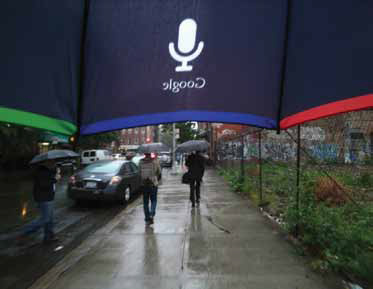Google has been getting a lot of media attention around its augmented reality (AR) internet-enabled glasses—Google Glass. The starting point for the media blitz was the announcement of a contest where up to 8,000 potential “invitees” could become Glass Explorers and get their hands on a pre-release set of the glasses. Of course there are a few details—submission of a 50-word essay, videos, photos, it must be a compelling application for the technology, and of course if “invited” the cost of $1,500 + tax and you have to pick it up in person in New York, San Francisco, or Los Angeles.
If you aren’t familiar with Glass, it is a lightweight eyeglass frame that has a small translucent monitor affixed to the top right corner for viewing, and a front-facing camera for photos and video streaming. Connectivity is achieved via a built-in Wi-Fi transceiver or via Bluetooth connectivity to a mobile device using its 3G or 4G data connection. It is capable of displaying all things internet and capturing anything you see for transmission to anyone you choose. Although the product won’t be widely available until 2014, it is an interesting technology that may have an impact on the AV industry.
Originally known as “Project Glass,” Google Glass was developed by Google X, a top-secret R&D facility. From the beginning the intent of the project was to develop an augmented reality (AR) headmounted display that would display information hands-free and interact with the internet through voice commands. Not exactly a new idea; development of head-mounted displays date back to the mid- ’60s. The term “augmented reality” is attributed to Tom Caudell, a former research scientist in Boeing’s Computer Services’ Adaptive Neural Systems Research and Development group in 1990.
Throughout the ’90s there were a variety of prototypes of AR systems developed, but in true reality they were toys for researchers and scientists. That began to change after Dr. Hirokazu Kato of the Nara Institute of Science and Technology released his ARToolKit in 1999, a software library for building AR applications. As bandwidth availability increased and the size, capabilities, and price decrease on processors, displays, and camera technology, the consumer application of AR is becoming reality.

Google has an interesting demonstration of the technology on its website that shows the typical applications that you might think of, including video calls, real-time navigation, voice-activated recording, and personal assistant lookup (think Siri). As I watched the video it became clear that Google Glass or similar devices will soon become another BYOD that IT and AV will be dealing with in the workplace. So where might this technology be applicable in our business? A few ideas to consider…
Education is one of the first that comes to mind. For K-12 it would be a fantastic tool for virtual field trips. In higher education it could extend existing curriculum with additional graphic, video, and audio information. In a distance learning application it could be used as an alternative content display.
In healthcare, displaying patient vitals for surgeons and doing patient record lookups are logical applications. Also, providing a surgeon’s view with verbal commentary for remote medical students would be a valuable tool and creates an opportunity for media storage and management solutions to enable viewing at a later time.
Manufacturing is another area where this type of source device is needed for remote repair, diagnosis, and tracking of complex equipment. Similarly, in the construction industry, this type of device could be used for remote project management while improving collaborative decision-making.
In your own business it would be valuable for field techs to be able to access system drawings, operational manuals, and technical bulletins via voice command.
Although the AV industry will most likely not directly sell a product like Google Glass, it will drive a variety of application opportunities for all of us. Keeping ahead of the greatest and latest technology is no longer an option, but a requirement for us to remain successful.
R. Randal Riebe (randy.riebe@polycom.com) is the director of AV integrator business development at Polycom.
Other Developments
Although Google Glass is the one AR technology currently getting a lot of media attention, there is ongoing development of a variety of AR technologies ranging from displays to input devices. On the display side, a technology that is within reach and is currently in the early prototype stage is the bionic contact lens. The technology combines integrated control circuits, LEDs, miniature antennas, and wireless communication circuits into the lens. The basic technologies are in place and limited prototypes have been developed and are being tested. Did Arnie say “I’ll be back” or “Eye’ll be back”?
Another area of development is the retinal projector a.k.a. virtual retinal display or retinal scan display. Basically a projector that draws a raster display directly on your eye using ultra-low-power lasers. Microvision released a product in 2004 called the Nomad Expert Technician System utilizing this technology in a headworn apparatus that projected images in red. It was designed and marketed toward the automotive industry. The product allowed automotive technicians to view service manuals directly over their workspace, increasing productivity and improving quality control (guess my idea of using it for a tech to view system drawing and manuals wasn’t original!).
Turning to the input device technologies, we are all familiar with the developments in voice-recognition technology but one of the other cool technology areas that would fit well with Google Glass is the virtual keyboard display. There are already a variety of devices on the market that utilize lasers for projection of a keyboard on any surface and infrared technology for mapping multiple reflections defining multiple keystrokes. If you think “user interface” instead of a keyboard things get interesting. Combine this technology with the capabilities of Google Glass and you have a completely natural and extremely powerful AV device. So what’s next? Your job is to figure out the applications that will bring value to your customers and bring customers to you.
—R.R.
